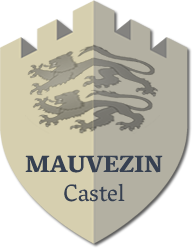History of the castle
The first castle
The original structure was a motte-and-bailey castle, built on an artificially raised mound, probably some time around the 11th century. The tower was roughly 10 feet high, made from wood and surrounded by a protective fence.
Two outer courtyards at its base with houses were surrounded by protective ditches and wooden fences. The largest one, on the southern side was approximately 13 yards across. Gaston Febus later expanded it to its current size in the 14th century. The second, smaller courtyard was located directly at the base of the current keep and has been used as the village cemetery since 1849.
The castle dominated a fortified village which extended all the way down to the church. You can still see the sharp slopes on each side of the road leading up to the castle, remnants of the fortifications that once stood there. The village entrance was probably guarded by a fortified gate. This configuration, with a castle perched on the highest point overlooking a fortified village built around a single main street evokes the first “castelnaus” – an Occitan term that roughly translates as “new castle”.
The first mention of the castle can be found in a peace treaty between Sanche de Labarthe and Countess Beatrix of Bigorre dated 12 March 1083. Due to its strategic location on the border between the lands of Bigorre, Comminges, Armagnac, Aure, and Labarthe, it was used on many occasions as a peace offering, such as when Countess Petronille of Bigorre ceded it to the Count of Comminges in 1232.
Disputed during the Hundred Years War, it was besieged by King Charles V’s brother, the Duke of Anjou, and the event was recorded by the famous medieval chronicler Froissart.
In 1379, it was passed on to Gaston Febus who incorporated it to his nearby holdings in Nebouzan.
The outer walls flanked with buttresses were built during the 13th century and initially rose to the level of the inner courtyard. Gaston Febus (30 April 1331 – 1391) later added the 120 feet high keep and had the battlements added.
Jean de Foix-Grailly (1382 – 1436) refurbished it as his main residence and engraved his proud house motto “J’ay Belle Dame” (I have fair lady) onto the heraldic stone located above the main gate.
The castle played a major role during the Wars of Religion especially when it was used as a jail for Protestants.
Upon becoming a national asset during the French Revolution, it somehow became the property of the town of Mauvezin and was used as a stone quarry by its inhabitants.
In 1862, the deputy of the Hautes-Pyrenées department bought it back from the town, intending to restore it to its former glory, but the project never got started. In 1906, his family sold the castle to Albin Bibal, the mayor of the nearby village of Masseube, who planned to consolidate the structure before opening it to the public. On March 28, 1907, Albin donated the castle to the Escola Gaston Febus, which still owns it to this day and is responsible for the vast majority of the restoration work.






.jpg)


